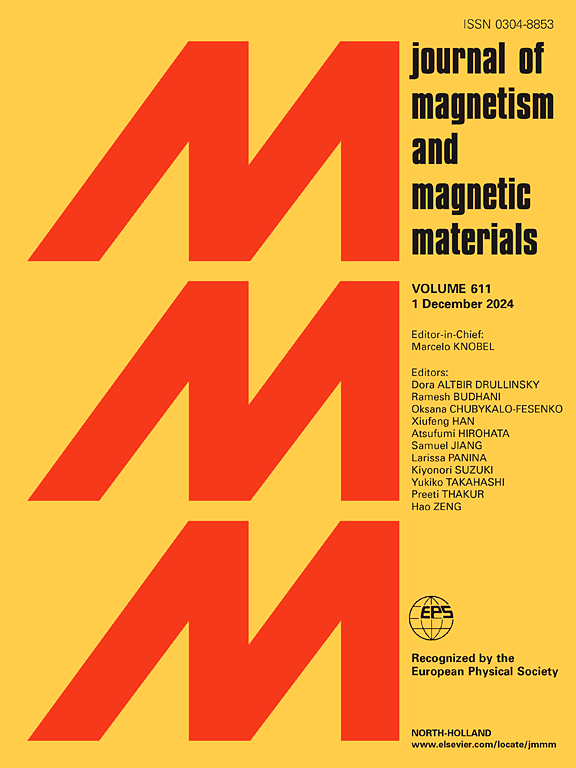Steady high-frequency antiskyrmion oscillator with anisotropic Dzyaloshinskii-Moriya interaction
IF 2.5
3区 材料科学
Q3 MATERIALS SCIENCE, MULTIDISCIPLINARY
引用次数: 0
Abstract
Magnetic skyrmions have garnered significant interest in recent years due to their potential applications in spintronic devices, such as spin-torque nano-oscillators (STNOs) and racetrack memory. However, the development of skyrmion-based STNOs has been hindered by their sub-GHz operational frequencies and propensity for annihilation under high current densities. In this study, stable antiskyrmion auto-oscillations in nanodisk geometries driven by spinpolarized currents enabled by anisotropic Dzyaloshinskii-Moriya interaction (DMI) were demonstrated. Through systematic comparisons of isotropic and anisotropic DMI systems, we uncover distinct topological stabilization mechanisms and current–density-dependent dynamics. At intermediate current densities (10–15 × 1011 A·m−2), antiskyrmions exhibit a hybrid breathing-rotational mode, achieving oscillation frequencies of 9.66 GHz (in-plane) and 38.8 GHz (out-of-plane), with a robust frequency ratio of 3.9–4.1. Notably, antiskyrmions sustain current densities up to 400 % of the annihilation thresholds for conventional skyrmions, attributed to their unique chirality-dependent force equilibration. The tangential velocity of antiskyrmions reaches 587 m/s at 15 × 1011 A·m−2, governed by competing dependencies on current density and size contraction. These findings establish antiskyrmion-based STNOs as promising platforms for high-frequency, low-power spintronic applications, overcoming critical limitations of conventional skyrmion systems.
具有各向异性Dzyaloshinskii-Moriya相互作用的稳定高频反斯基子振荡器
近年来,由于其在自旋电子器件(如自旋力矩纳米振荡器(STNOs)和赛道存储器)中的潜在应用,磁性skyrmions引起了人们的极大兴趣。然而,基于skyrmion的STNOs的发展一直受到其低于ghz工作频率和高电流密度下湮灭倾向的阻碍。在本研究中,证明了由各向异性Dzyaloshinskii-Moriya相互作用(DMI)实现的自旋极化电流驱动的纳米盘几何结构中稳定的反skyrmion自振荡。通过对各向同性和各向异性DMI系统的系统比较,我们揭示了不同的拓扑稳定机制和电流密度相关的动力学。在中等电流密度(10-15 × 1011 A·m−2)下,反skyrmions表现出混合呼吸-旋转模式,振荡频率为9.66 GHz(面内)和38.8 GHz(面外),鲁棒频率比为3.9-4.1。值得注意的是,由于其独特的手性依赖的力平衡,反skyrmions维持的电流密度高达传统skyrmions湮灭阈值的400%。在15 × 1011 A·m−2条件下,反天子的切向速度达到587 m/s,受电流密度和尺寸收缩的竞争影响。这些发现使基于反skyrion的STNOs成为高频、低功率自旋电子应用的有前途的平台,克服了传统skyrion系统的关键限制。
本文章由计算机程序翻译,如有差异,请以英文原文为准。
求助全文
约1分钟内获得全文
求助全文
来源期刊

Journal of Magnetism and Magnetic Materials
物理-材料科学:综合
CiteScore
5.30
自引率
11.10%
发文量
1149
审稿时长
59 days
期刊介绍:
The Journal of Magnetism and Magnetic Materials provides an important forum for the disclosure and discussion of original contributions covering the whole spectrum of topics, from basic magnetism to the technology and applications of magnetic materials. The journal encourages greater interaction between the basic and applied sub-disciplines of magnetism with comprehensive review articles, in addition to full-length contributions. In addition, other categories of contributions are welcome, including Critical Focused issues, Current Perspectives and Outreach to the General Public.
Main Categories:
Full-length articles:
Technically original research documents that report results of value to the communities that comprise the journal audience. The link between chemical, structural and microstructural properties on the one hand and magnetic properties on the other hand are encouraged.
In addition to general topics covering all areas of magnetism and magnetic materials, the full-length articles also include three sub-sections, focusing on Nanomagnetism, Spintronics and Applications.
The sub-section on Nanomagnetism contains articles on magnetic nanoparticles, nanowires, thin films, 2D materials and other nanoscale magnetic materials and their applications.
The sub-section on Spintronics contains articles on magnetoresistance, magnetoimpedance, magneto-optical phenomena, Micro-Electro-Mechanical Systems (MEMS), and other topics related to spin current control and magneto-transport phenomena. The sub-section on Applications display papers that focus on applications of magnetic materials. The applications need to show a connection to magnetism.
Review articles:
Review articles organize, clarify, and summarize existing major works in the areas covered by the Journal and provide comprehensive citations to the full spectrum of relevant literature.
 求助内容:
求助内容: 应助结果提醒方式:
应助结果提醒方式:


